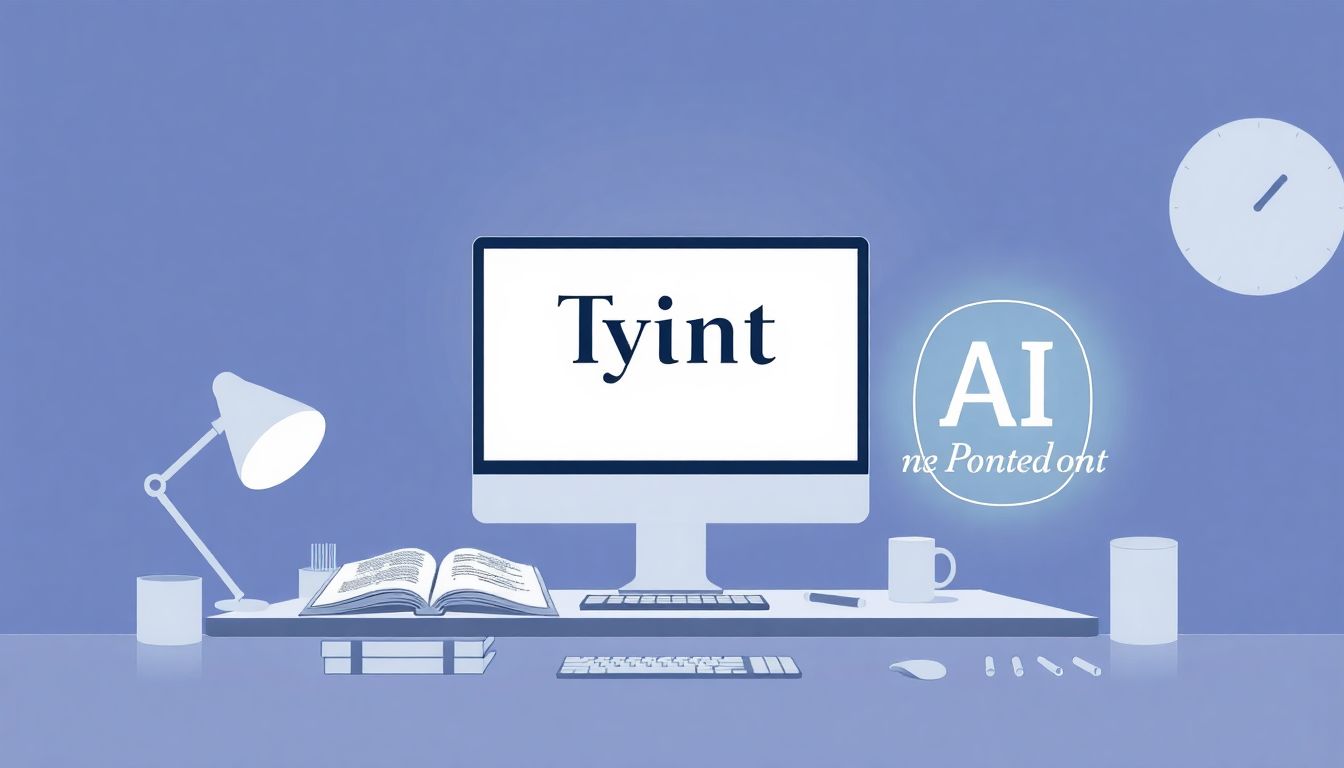If you’ve ever tried to create eye-catching typography but felt stuck or overwhelmed, you’re not alone. Many designers struggle to find the right tools that make font choices easier and more fun. Stay with me, because if you keep reading, you’ll discover how AI typography generators can boost your workflow and help craft stunning visuals effortlessly. In just a few minutes, you’ll learn about top tools and tips to pick the perfect AI font helper for 2025.
Key Takeaways
- Choose AI typography tools based on your needs for simplicity, customization, or unique fonts. Test free versions, consider workflow compatibility, and prioritize ease of use and export options to save time and boost creativity.
- Top tools like FontJoy, Typography.app, and Adobe’s solutions help streamline font generation with features like style variation and collaboration. Pick platforms that fit project size—large or quick social media content.
- Budget-friendly options like Typogram and Letterstep offer control and fun features for creative projects. AI blending tools like Artbreeder widen your font choices and help brainstorm unique styles.
- Integrate AI generators into your workflow by identifying key stages, using plugins or compatible formats, and creating presets for efficiency. Review and manually tweak fonts to add a personal touch.
- Focus on compatibility, features like export formats, and ease of use when selecting an AI typography tool. Check reviews and support to ensure reliability and stay current with updates.
- AI typography tools save time by automating adjustments and offering multiple style options quickly. They ensure consistency across projects and help generate fresh ideas, boosting productivity overall.
- Future trends point to more personalized, adaptable fonts and better team collaboration. AI will learn from your style, making font creation faster and more inventive, opening new creative possibilities.

1. How to Find the Best AI Typography Generator for Your Needs in 2025
Looking for an AI typography generator that fits your style and budget? Start by identifying your specific requirements—are you after simplicity, high customization, or unique fonts? Once you have that clear, explore tools with proven automation features like kerning, character consistency, and style variation.
Check for user reviews and real-world case studies. Tools like Adobe’s AI font solutions or emerging platforms such as Canva offer insights into how well they improve efficiency and output. Be sure to test their free versions or demos to see if the interface feels intuitive and if the generated fonts meet your standards.
A good rule of thumb is to prioritize tools that are compatible with your current design workflow, support collaborative features, and offer flexible export options for different formats like SVG or PNG. Remember, a powerful AI generator should save you time and inspire creativity, not complicate your process.
2. Leading AI Typography Tools for Businesses and Creatives in 2025
Some of the top AI typography tools in 2025 include platforms like FontJoy, which uses deep learning to generate harmony among fonts, and Typography.app, known for its effortless customization and fast font generation. These tools are favored by both big brands and freelance designers for their ease of use and high-quality outputs.
Adobe’s AI-driven font platform continues to lead with its robust integration into Creative Cloud, helping teams create consistent branding with less time. Meanwhile, startups like FontAI.io are pushing boundaries with innovative features such as style blending and AI-based kerning adjustments.
Choosing the right tool depends on your needs—if you’re handling large projects, a platform with batch processing and collaboration options is better. For quick social media content, look for tools that generate multiple styles instantly with minimal fuss.
3. Mid-Range and Creative AI Typography Generators to Try in 2025
If you’re looking for budget-friendly yet creative options, tools like Typogram and Letterstep offer impressive features for designers who want more control without breaking the bank. These platforms often provide fun style galleries, adjustable parameters, and easy export choices that suit creative projects.
For those who want to experiment with innovative font styles, platforms such as Artbreeder allow you to blend different typographic features using AI, opening up new possibilities beyond traditional fonts. These generators are great for brainstorming ideas or creating custom-type treatments for branding or artistic projects.
Many of these tools come with free tiers or affordable subscriptions, making them accessible for freelancers, small teams, or hobbyists eager to explore AI-generated typography in their work.

4. How to Integrate AI Typography Tools into Your Design Workflow
Getting AI typography tools to work smoothly with your existing workflow requires a few simple steps.
First, identify which stages of your design process can benefit most from AI assistance—whether it’s initial font brainstorming, refining kerning, or creating multiple style variations quickly.
Next, choose tools that support your preferred file formats and have plugins or integrations with your main design software, like Adobe Photoshop or Illustrator.
Set up your workspace to include AI tools as either standalone applications or integrated within your design platform to streamline transitions between steps.
Don’t forget to create templates or preset styles within the tools to make repetitive tasks faster, especially if you regularly generate similar font styles or layouts.
Finally, establish a routine to review and tweak AI-generated fonts manually, because even with automation, human touch ensures the little nuances that make designs stand out.
5. Key Factors to Consider When Choosing an AI Typography Generator
When picking an AI typography generator, focus on a few specific points to avoid wasting your time.
Compatibility is key—you want a tool that plays well with your current software and hardware setup.
Look for features like style variation, kerning control, and the ability to export in multiple formats like SVG, PNG, or even vector files for further editing.
Ease of use matters, especially if you need to create fonts on tight deadlines or if you’re not very tech-savvy.
Check out reviews or ask for demo versions to see how intuitive and reliable the tool feels in real-world use cases.
Also, consider the support and update policy—regular updates mean the tool stays current with new design trends and AI improvements.
6. How AI Typography Generators Can Make Your Design Process Smarter
AI typography tools can sharpen your work in several ways that save you time and boost creativity.
For starters, they automate tedious tasks like kerning adjustments and style consistency, freeing you up to focus on the creative side.
Many generators can produce dozens of font variations in seconds, helping you to pick the best fit without starting from scratch each time.
If you’re working on big branding projects, AI tools can ensure uniformity across multiple assets, like logos, posters, and social media graphics.
Another perk is their ability to suggest styles you might not have considered, giving your designs a fresh twist.
Using these tools consistently can increase your productivity by about 20%, according to recent industry insights, and cut down on design costs too.
7. What Are the Future Trends of AI Typography in 2025 and Beyond?
Looking ahead, AI typography is set to become even more integrated into daily design work, making customization faster and more precise.
We’ll see more tools that learn from your style preferences over time, reducing repetitive adjustments and automating creative decisions.
Fundamentally, AI-generated fonts will become more personalized and adaptable, allowing for dynamic typography that responds to context or user interaction.
Better collaboration features will emerge, enabling teams to share and refine AI-generated styles seamlessly across platforms.
Hype aside, the market is expected to grow significantly—by 2025, the AI text generator industry alone will be worth around USD 488.63 million, and the typography segment will drive part of this expansion.
This trend means designers of all levels will have access to tools that make typography not just easier but more inventive than ever before, leading to richer, more engaging visual content.
FAQs
Select a tool that matches your design requirements, offers diverse font options, and integrates well into your workflow. Consider user reviews and trial versions to assess ease of use and output quality before committing.
Leading options include tools that provide advanced customization, collaborative features, and high-quality results. Popular choices include Adobe Font Generator, Canva AI Fonts, and other platforms known for user-friendly interfaces and reliable outputs.
Mid-range tools often balance features and affordability. Examples include Looka Fonts, Figma plugins with AI features, and smaller platforms offering customizable typography options suitable for various projects.
Start by choosing compatible tools that support your design software. Use plugins or APIs to connect AI generators with your workflow, and allocate time for testing outputs to ensure smooth integration.